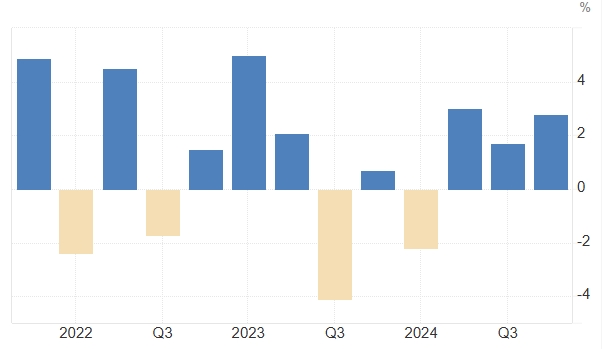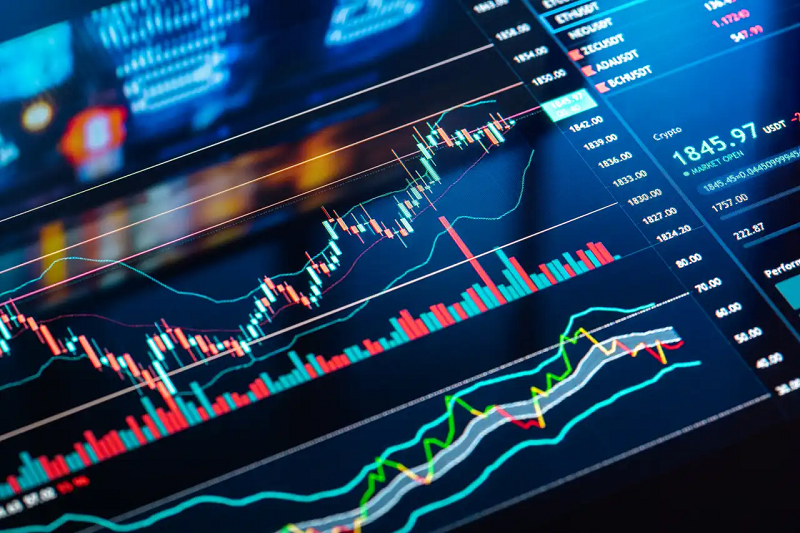Japan's GDP Expands for 3 Consecutive Quarters: Will the BOJ Hike Rates Sooner? Trump Matters!

TradingKey – With the release of Japan's Q4 2024 GDP data, the case for the Bank of Japan (BOJ) raising interest rates in January has become more solid, and the market is beginning to consider the possibility of the BOJ raising rates sooner. However, Trump's tariffs remain a risk factor.
On Monday, February 17, Japan released preliminary data for last quarter’s and full-year 2024 economic growth. Japan’s economy grew more than expected in the fourth quarter, and annual nominal GDP exceeded 600 trillion yen for the first time. However, real GDP only increased by 0.1%.
- Q4 2024 GDP: Annualized quarterly growth rate of 2.8%, exceeding the expected 1.1%, accelerating from 1.7% in Q3.
- Nominal GDP in 2024: 2.9% YoY growth, reaching 609 trillion yen, marking positive growth for the fourth consecutive year.
- Real GDP in 2024: 0.1% YoY growth, totaling 557 trillion yen.

[Annual Growth Rate of Japan's GDP, Source: Trading Economics]
The fact that Japan’s nominal GDP exceeded the 600-trillion-yen mark for the first time in history in 2024 is highly significant. This was an economic goal set by then-Prime Minister Shinzo Abe in 2015, with the target of reaching 600 trillion yen by 2020.
The NIKKEI pointed out that since 1973, Japan's nominal GDP has increased by about 100 trillion yen every five years. However, after surpassing 500 trillion yen in 1992, it has been in long-term stagnation.
Japan's average nominal GDP growth rate declined from about 7% in the 1980s to zero growth in the early 2000s. Japan's “Lost 30 Years” period has left a lasting impression. Now, with inflation, wages, and economic growth trends turning positive, expectations for the BOJ raising interest rates further have strengthened.
Bank of Japan's Interest Rate Hikes
The Bank of Japan has implemented three interest rate hikes in March 2024, July 2024, and January this year. The key reason for the rate hikes is Japan's sustainable wage-inflation growth outlook.
Following the report, the USD/JPY fell slightly by 0.34% intraday, to 151.71. The 10-year Japanese government bond yield rose by 0.025, reaching 1.375%, the highest level since 2010.
Mitsubishi UFJ Morgan Stanley now expects the Bank of Japan to raise the current benchmark interest rate from 0.5% to 0.75% in July, rather than in the October-December period.
Former BOJ official Nobuyasu Atago stated that the BOJ is expected to raise interest rates at the April 30-May 1 meeting.
Risks Remain for Japan's Economic Growth
Although the overall economy is growing, this report still has some "weak points":
1. Nominal personal consumption increased by 2.1% YoY, but real personal consumption decreased by 0.1% YoY, marking the first negative growth in four years.
This indicates that personal consumption has not kept pace with inflation, which could suppress future consumption.
2. Net exports contributed to overall economic growth, but part of the reason for the growth in net exports is a decline in imports, which may raise concerns about weak domestic demand in Japan.
Additionally, Trump may announce tariffs on imported cars on April 2, posing a challenge to Japan’s export-oriented economy, where the automotive industry accounts for a large share of exports.
Throughout 2024, Japan’s total exports to the United States were 21.30 trillion yen, with passenger cars, trucks, and other vehicles accounting for 28.3%, the largest proportion of automotive exports to the US.







